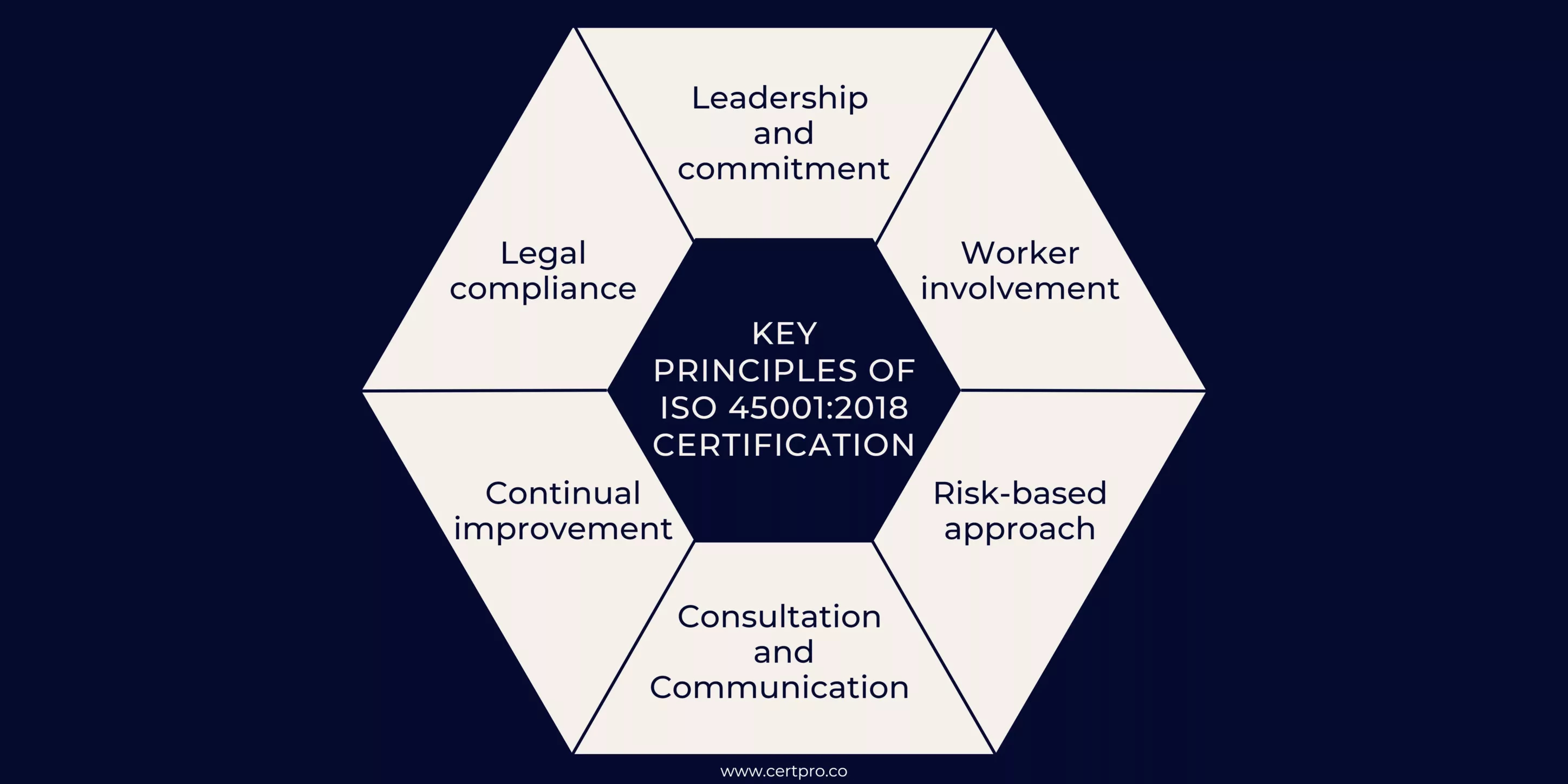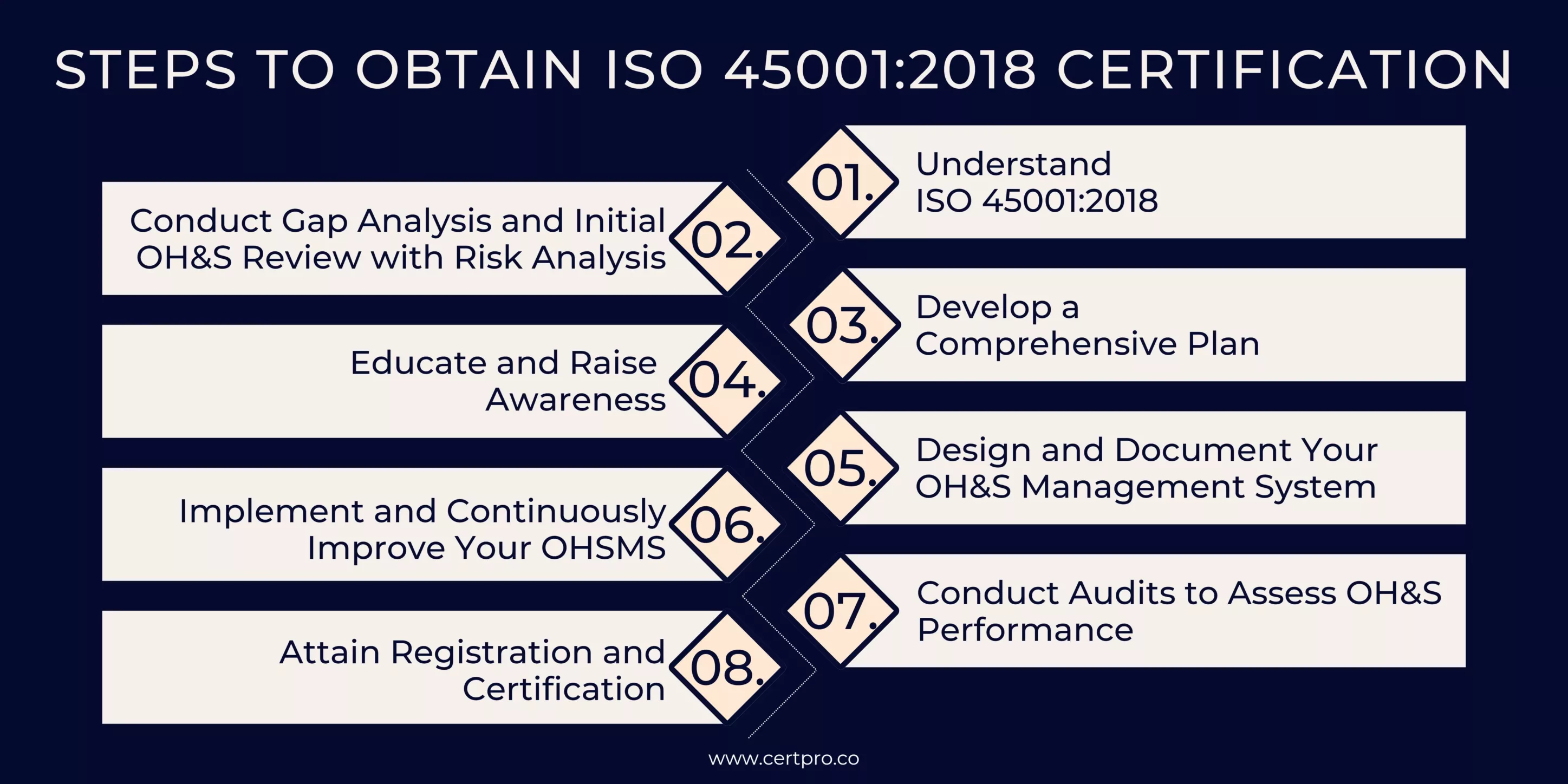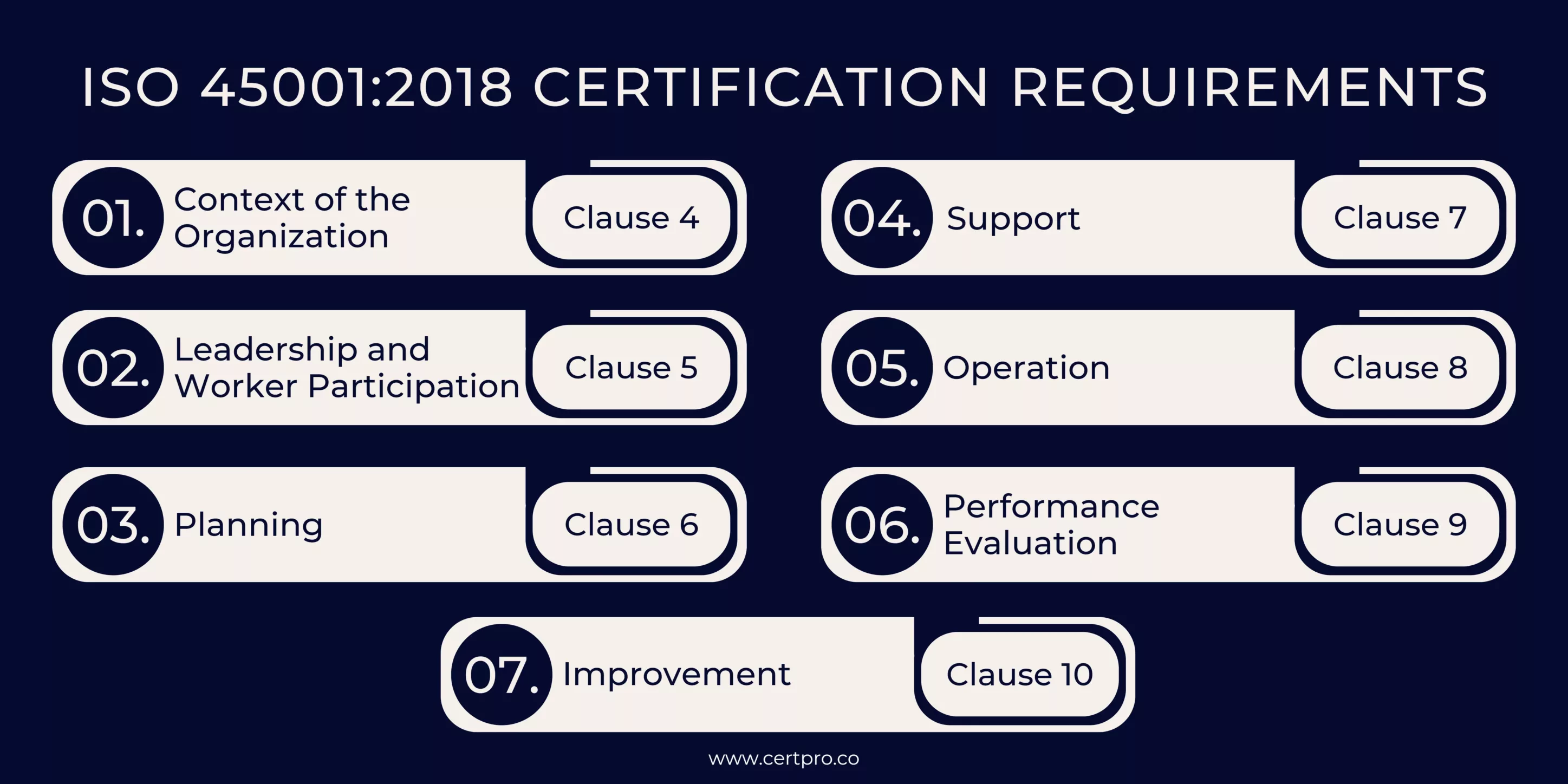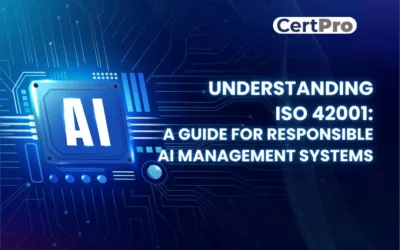ISO 45001:2018
OCCUPATIONAL HEALTH AND SAFETY MANAGEMENT SYSTEM
The ISO 45001:2018 certification is a globally recognized standard that establishes guidelines for effectively implementing and maintaining an occupational health and safety management system (OHSMS) within an organization. Its primary objective is to safeguard the well-being of employees by ensuring a secure and healthy work environment. This certification serves as evidence of an organization’s dedication to identifying and managing risks, reducing workplace accidents, and fostering a safety-conscious culture.
ISO 45001 assists organizations in establishing structured processes for identifying hazards, assessing risks, and implementing control measures. Its ultimate goal is to promote a work environment that prioritizes safety and health. By proactively identifying and managing potential risks and hazards, this certification protects the well-being of employees and other stakeholders. It emphasizes a systematic approach to risk management, fostering the creation of a safe and healthy workplace. Furthermore, it emphasizes the significance of worker involvement, consultation, and participation, encouraging a collaborative approach to safety management.
Implementing the ISO 45001:2018 standard empowers organizations to improve their ability to prevent work-related injuries, illnesses, and fatalities. It provides a comprehensive framework that addresses various critical aspects, including hazard identification, risk assessment, emergency preparedness, and incident investigation. By adhering to this standard, organizations can enhance their overall safety performance and ensure the health and well-being of their workforce.

Certification and Auditing Services by CertPro for ISO 45001:2018
At CertPro, we understand the significance of effective occupational health and safety management, along with the value of ISO 45001:2018 certification for organizations committed to improving their safety performance. We offer comprehensive guidance to organizations pursuing ISO 45001:2018 certification. Our team of proficient professionals will assist you throughout the certification journey, ensuring that your organization’s health and safety management practices align with the latest ISO standards. We will collaborate closely with your team to design and implement an efficient OH&S (Occupational Health and Safety) Management System tailored to your specific requirements and industry standards.
Why choose CertPro for ISO 45001:2018 certification and auditing?
CertPro distinguishes itself as a reliable partner in the field of ISO 45001:2018 certification and auditing services. Leveraging our extensive experience of nearly ten years in the industry, we have refined our capabilities and acquired a profound knowledge of occupational health and safety management. Here are several persuasive motives to select CertPro as your preferred partner for ISO 45001:2018 certification:
| Factors | CertPro Advantage |
|---|---|
| Time to Certification | 4x faster than traditional approaches |
| Price | Competitive rates with flexible options |
| Process | Streamlined and efficient methodology |
| Expertise | 10+ years of industry experience |
CertPro’s Cost-Effective Approach to ISO 45001:2018 Certification
When contemplating ISO 45001:2018 certification, the total cost can sometimes seem daunting, incorporating several factors that impact the overall expenditure. At CertPro, we acknowledge the significance of cost-effectiveness and are committed to delivering budget-friendly solutions customized to your organization’s requirements. Here is a summary of our cost-effective strategy for ISO 45001:2018 certification:
| No. of employees | Timeline | Cost (approx.) |
| 1 – 25 | 4 weeks | 2500 USD |
| 25-100 | 6 weeks | 4500 USD |
| 100-250 | 8 weeks | 7500 USD |
| 250 plus | 8-12 weeks | Custom plans |
UNDERSTANDING ISO 45001:2018 AND ITS BASICS
ISO 45001 is an international standard that provides a framework for managing and preventing work-related injuries, illnesses, and fatalities. The International Organization for Standardization (ISO) published the ISO 45001 standard in March 2018. The primary purpose of ISO 45001 is to improve occupational health and safety and create a safe and healthy workplace for workers and others who interact with the organization. The scope of ISO 45001 encompasses all types of organizations, regardless of their size, industry, or geographical location. It applies to internal and external factors that affect occupational health and safety. The standard emphasizes the importance of identifying hazards, assessing risks, and implementing controls to prevent incidents and promote a safe working environment.
ISO 45001 promotes a proactive approach to occupational health and safety management, focusing on continual improvement, worker participation, and leadership commitment. It encourages organizations to establish clear objectives, implement effective processes, and ensure compliance with legal and regulatory requirements related to occupational health and safety. By adopting ISO 45001, organizations can enhance their safety culture, reduce accidents and injuries, improve employee well-being, and demonstrate their commitment to providing a safe and healthy workplace for their workforce and stakeholders.
The standard emphasizes the importance of risk assessment, which involves identifying and evaluating potential hazards and risks. Risk treatment involves implementing controls and measures to mitigate or eliminate identified risks. Continuous improvement is a fundamental aspect, requiring organizations to monitor, evaluate, and enhance their OH&S performance continually. ISO 45001 certification is beneficial for any organization that wants to demonstrate its commitment to workplace safety, including businesses of all sizes, industries, and sectors. It is particularly important for organizations with high-risk activities or those seeking to improve their occupational health and safety management practices.
KEY PRINCIPLES OF ISO 45001:2018 CERTIFICATION
The key principle of ISO 45001:2018 certification is the promotion of occupational health and safety (OH&S) within an organization. ISO 45001 is an international standard that provides a framework for organizations to establish, implement, maintain, and continually improve an OH&S management system.
The key principles of ISO 45001:2018 certification are as follows:
- Leadership and commitment: Top management plays a crucial role in demonstrating leadership and commitment to occupational health and safety. They are responsible for establishing an effective OH&S management system, setting OH&S objectives, and providing the necessary resources.
- Worker involvement: The standard emphasizes the involvement and participation of workers at all levels. Organizations should provide opportunities for workers to contribute to decision-making processes, report hazards, and actively participate in OH&S initiatives.
- Risk-based approach: ISO 45001 promotes a proactive approach to managing occupational health and safety hazards and risks. Organizations are required to identify potential hazards, assess risks, and implement appropriate control measures to eliminate or minimize risks to workers’ health and safety.
- Continual improvement: ISO 45001 emphasizes the importance of continually improving the OH&S management system. Organizations should regularly monitor performance, conduct internal audits, and review the effectiveness of their processes to identify areas for improvement and take appropriate corrective actions.
- Legal compliance: Compliance with applicable legal and regulatory requirements related to occupational health and safety is a fundamental aspect of ISO 45001 certification. Organizations must be aware of and fulfill their legal obligations to protect the health and safety of their workers.
- Communication and consultation: Effective communication and consultation with workers and other relevant stakeholders are essential for the successful implementation of an OH&S management system. Organizations should establish mechanisms for clear and timely communication on OH&S matters and consult workers on issues that affect their health and safety.
By adhering to these key principles, organizations can achieve ISO 45001:2018 certification and demonstrate their commitment to providing a safe and healthy working environment for their employees.

STEPS TO OBTAIN ISO 45001:2018 CERTIFICATION
Obtaining ISO 45001 certification involves the following processes:
Step 1: Understand ISO 45001:2018
Gain knowledge of the ISO 45001:2018 standard and its requirements, ensuring you comprehend the principles and elements of an effective occupational health and safety management system (OH&S). Familiarize yourself with the standard’s requirements and its relationship with ISO 14001 and ISO 9001, if applicable.
Step 2: Conduct Gap Analysis and Initial OH&S Review with Risk Analysis:
Evaluate your current OH&S practices and identify gaps between your existing system and the requirements of ISO 45001. Perform a thorough risk analysis to identify potential hazards and risks.
Step 3: Develop a Comprehensive Plan:
Create a detailed plan that outlines the necessary actions, resources, and timelines for implementing ISO 45001 within your organization. Ensure the plan addresses the identified gaps and includes strategies for risk management.
Step 4: Educate and Raise Awareness:
Train and educate your employees on the importance of OH&S and ISO 45001:2018. Foster a culture of awareness, participation, and commitment to safety throughout the organization.
Step 5: Design and Document Your OH&S Management System:
Design and document the OH&S management system, including the necessary procedures and processes to meet the standard’s requirements. Consider using templates and support resources to streamline this process.
Step 6: Implement and Continuously Improve Your OHSMS:
Implement the OH&S management system, ensuring employees follow the procedures, collect records, and continually seek opportunities for improvement over a few months.
Step 7: Conduct Audits to Assess OH&S Performance:
Perform internal audits to assess the performance of your OH&S management system. Ensure compliance with ISO 45001 and identify areas for enhancement. Prepare for the registrar’s registration audit.
Step 8: Attain Registration and Certification:
Select a registrar and undergo the registration audit. Correct any non-conformances found during the audit to achieve certification. Maintain compliance by having the registrar conduct regular surveillance audits. Utilize the certification to promote your ISO 45001 compliance and commitment to occupational health and safety. If successful, you will receive ISO 45001 certification, demonstrating your organization’s commitment to occupational health and safety.

ISO 45001:2018 CERTIFICATION REQUIREMENTS
The ISO 45001:2018 standard is structured into 10 sections (clauses). Sections 1–3 provide information on the scope, references, and definitions. Sections 4–10 focus on the occupational health and safety (OH&S) requirements, covering aspects such as organizational context, leadership, planning, support, operation, performance evaluation, and improvement.
Clause 4: Context of the Organization: Identify internal and external factors relevant to the organization’s OH&S, determine interested parties, and assess risks and opportunities related to their OH&S performance. Define scope and establish OH&S objectives.
Clause 5: Leadership and Worker Participation: Emphasizes the need for top management’s commitment, leadership, and active worker involvement in establishing and maintaining the OH&S management system.
Clause 6: Planning: Requires organizations to set OH&S objectives, develop plans to achieve them, and address opportunities and risks. It includes activities such as hazard identification, risk assessment, risk treatment, consideration of legal requirements, and planning actions to manage OH&S risks and achieve the established objectives.
Clause 7: Support: Focuses on providing the resources, competence, awareness, communication, and documented information necessary to support the effective implementation of the OH&S management system.
Clause 8: Operation: Implement and control operational processes, manage changes, establish emergency preparedness, and ensure contractors and suppliers comply with OH&S requirements.
Clause 9: Performance Evaluation: Highlights the importance of monitoring, measuring, and analyzing OH&S performance, conducting internal audits, and conducting management reviews to ensure continual improvement.
Clause 10: Improvement: Encourages organizations to take corrective actions, learn from incidents, implement preventive measures, and strive for continual improvement of the OH&S management system.

BENEFITS OF ISO 45001:2018 CERTIFICATION
- Improve employee safety: ISO 45001:2018 helps enhance workplace safety measures, protecting employees from potential hazards.
- Increase productivity: A safe and healthy work environment promotes productivity and reduces downtime due to accidents or injuries.
- Lower insurance costs: Effective implementation of the standard can lead to reduced insurance premiums due to lower risk profiles.
- Reduce risk: The standard emphasizes risk management, enabling organizations to identify and mitigate potential hazards and risks effectively.
- Stand out as an industry leader: Certification sets organizations apart by showcasing their commitment to best practices in OH&S management.
- Shift from reactive to proactive: ISO 45001 encourages a proactive approach to identify and address potential hazards before incidents occur.
- Engage employees in safety: Involving employees in the OH&S management system fosters a safety culture and promotes active participation in safety initiatives.
- Identify opportunities: ISO 45001 helps identify areas for improvement and potential opportunities to enhance occupational health and safety performance.
- Boost stakeholder confidence: Certification demonstrates the organization’s commitment to occupational health and safety, instilling trust and confidence in stakeholders.
- Gain a competitive advantage: ISO 45001 certification can provide a competitive edge by demonstrating a strong dedication to safety and meeting customer requirements.
- Foster management involvement & accountability: ISO 45001:2018 promotes management’s active involvement and accountability in driving a robust occupational health and safety management system.
- Demonstrate your commitment to safety: Certification showcases an organization’s commitment to maintaining the highest standards of occupational health and safety, reinforcing its reputation.
ELIGIBILITY FOR ISO 45001:2018 CERTIFICATION
ISO 45001:2018 certification is available to businesses of any size, sector, or location, irrespective of their specific attributes, and aims to prioritize occupational health and safety. The ISO 45001 standard is intended to help organizations establish an effective OH&S management system, ensuring the well-being of their employees and stakeholders. Legal requirements do not limit eligibility for ISO 45001 certification; rather, it depends on a commitment to implementing and upholding the standard’s requirements. By pursuing certification, businesses can showcase their dedication to providing a safe working environment, reducing occupational risks, and continuously improving their OH&S performance. This certification is particularly relevant for organizations that want to enhance their occupational health and safety practices, meet customer and stakeholder expectations, and gain a competitive advantage. It is a valuable tool for organizations seeking to uphold safety standards and demonstrate their commitment to employee well-being.
THE COST OF ISO 45001:2018 CERTIFICATION
The ISO 45001:2018 certification cost encompasses various factors such as implementing the management system, purchasing the necessary standards, attending training classes, and engaging consultants and auditors. The expenses involved depend on the size and complexity of the organization.
While the initial investment may seem significant, a well-executed ISO 45001 management system can yield long-term cost savings. By managing occupational health and safety, organizations can reduce accidents, injuries, and incidents, resulting in lower insurance premiums, reduced absenteeism, and improved productivity. Furthermore, the implementation of proactive risk assessment and preventive measures can prevent costly legal penalties and reputational damage. Therefore, the cost of ISO 45001 certification should be viewed as an investment in creating a safer work environment, protecting employees’ well-being, and enhancing overall business performance.
ADDRESSING CHALLENGES AND IMPLEMENTING SOLUTIONS IN ISO 45001:2018 CERTIFICATION
Challenge 1: Establishing a culture of health and safety
Employees may not prioritize health and safety if they haven’t experienced incidents or accidents.
Solution: Provide training, raise awareness, and involve employees in creating the Occupational Health and Safety Management System (OHSMS). Engage employees and value their opinions to foster a culture of safety.
Challenge 2: Meeting legislation
Ensuring compliance with local regulations and laws in different regions where the organization operates.
Solution: Employ a specialist in occupational health and safety or seek external expertise to ensure OHSMS rules and initiatives align with relevant legislation. Verify the candidate’s knowledge and ability, or request references for external hires.
Challenge 3: Top management support
Lack of commitment and communication from top management in emphasizing the importance of health and safety.
Solution: Encourage top management to demonstrate commitment, lead by example, and communicate effectively. Define roles, responsibilities, and authority within the OHSMS to ensure their involvement and visibility.
Challenge 4: Support of the team
It is an overwhelming task for a single person to establish the OHSMS without assistance from knowledgeable team members.
Solution: Seek support and expertise from team members who have a better understanding of the company and its products. Foster participation, consultation, and effective communication to build knowledge and trust within the team.
Challenge 5: Organizational setup
Managing health and safety requirements across multiple sites with varying functions and locations.
Solution: Assess activities, processes, and controls across all sites and tailor the OHSMS controls to meet the specific needs of each location. Customize provisions and guidelines according to the different outputs of the sites, ensuring safety requirements are met.
By addressing these challenges and implementing the suggested solutions, organizations can navigate the process of ISO 45001 certification more effectively and ensure a safer work environment for their employees.
ENSURING ISO 45001:2018 CERTIFICATION VALIDITY
The validity of ISO 45001:2018 certification depends on several factors. ISO 45001 certification is usually valid for three years initially. Organizations are subject to surveillance audits by the certification body during this time to ensure ongoing compliance with the standard. Organizations must demonstrate that they have maintained and improved their occupational health and safety management system to maintain the certificate.
After the initial three-year period, organizations go through a reassessment of the system to apply for recertification. This reassessment involves a comprehensive evaluation to determine if the organization continues to meet the requirements of ISO 45001. Successful recertification confirms that the organization has maintained its commitment to occupational health and safety and has implemented necessary improvements to its management system.
It’s important to note that the validity of ISO 45001 certification also depends on the organization’s commitment to ongoing compliance and continuous improvement. Organizations must proactively address any identified non-conformities and implement corrective actions to maintain the effectiveness of their OH&S management system.
CERTPRO: GUIDING YOUR BUSINESS TOWARD ISO 45001:2018 CERTIFICATION EXCELLENCE
CertPro specializes in assisting businesses to achieve ISO 45001 certification through comprehensive auditing, consulting, and certification services. With a team of experienced auditors and consultants, CertPro guides your business through the certification process, adhering to industry best practices. And assess your occupational health and safety management system, identify areas for improvement, and help implement effective health and safety policies and procedures. CertPro provides documentation support, training, and expert guidance to ensure compliance with ISO 45001 requirements. By partnering with CertPro, your business can demonstrate its commitment to employee safety, mitigate occupational hazards, and improve workplace health and safety performance. Attaining ISO 45001 certification with CertPro’s assistance enhances your organization’s reputation and strengthens your position in the market.
FAQ’s
HOW MUCH TIME DOES IT TAKE TO GET ISO 45001:2018 CERTIFIED?
The timeframe for ISO 45001 certification depends on various factors, including the organization’s readiness and the complexity of its operations. It typically takes several months to a year or more to implement the necessary systems, conduct audits, and address any non-conformities identified during the process.
WHAT OCCURS FOLLOWING THE ATTAINMENT OF ISO 45001:2018 CERTIFICATION?
After achieving ISO 45001 certification, organizations must maintain and improve their occupational health and safety management systems. It involves conducting internal audits, addressing non-conformities, performing management reviews, and undergoing regular surveillance audits to ensure ongoing compliance with the standard.
CAN ISO 45001:2018 BE INTEGRATED WITH OTHER MANAGEMENT SYSTEMS?
Yes, ISO 45001 can be integrated with other management systems, such as ISO 9001 for quality management and ISO 14001 for environmental management. This integration allows organizations to streamline their processes, eliminate duplication, and achieve synergies in managing health and safety, quality, and environmental aspects effectively.
WHAT IS THE COST ASSOCIATED WITH ISO 45001:2018 CERTIFICATION?
The cost of ISO 45001 certification varies depending on factors such as the size and complexity of the organization, the scope of the certification, and the chosen certification body. It typically includes expenses for implementation, training, audits, and ongoing maintenance and can range from a few thousand dollars to tens of thousands of dollars.
CAN ISO 45001:2018 CERTIFICATION IMPROVE A COMPANY'S REPUTATION AND MARKET COMPETITION?
Yes, ISO 45001 certification can enhance an organization’s reputation and market competitiveness. It demonstrates the organization’s commitment to occupational health and safety, instills confidence among stakeholders, and differentiates the organization from competitors. It can also attract clients, partners, and customers who prioritize safety and responsible business practices.
UNDERSTANDING ISO 42001: A GUIDE FOR RESPONSIBLE AI MANAGEMENT SYSTEMS
The invention of artificial intelligence (AI) has changed the operational processes of many industries. However, the rapid growth of technology increases ethical, security, and privacy-related concerns. Therefore, the International Organization for Standardization...
EUROPEAN UNION’S ARTIFICIAL INTELLIGENCE ACT: HOW THIS GROUNDBREAKING LAW AFFECTS YOUR BUSINESS
Nowadays, Artificial Intelligence (AI) is transforming our lives exceptionally well. AI is now streamlining healthcare services, providing virtual assistance, and fulfilling queries. Technologies have boons and curses. Similarly, AI creates many concerns about...
How to Implement GRC Frameworks in 2024: Step-by-Step Guide
The rapidly evolving business environment, complexity, and accountability enhance the importance of the organization's governance, risk management, and compliance initiatives. Therefore, if your company finds difficulties expanding, recheck your organization's...



